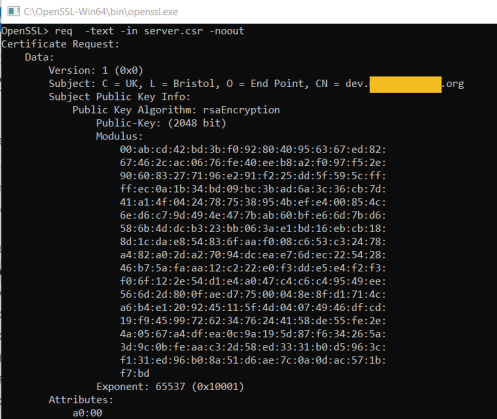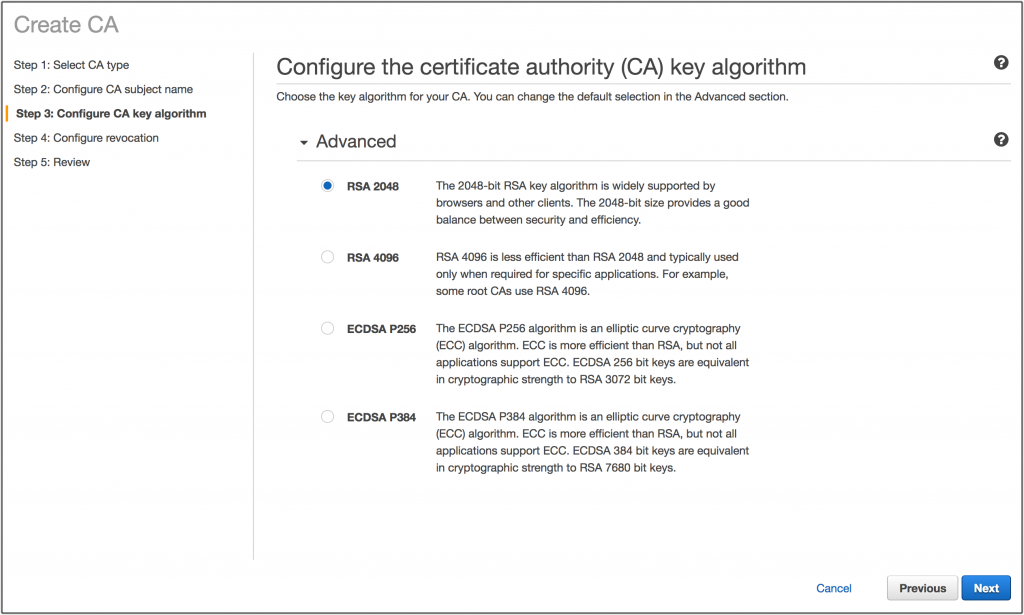Openssl Generate Certificate From Existing Key
- The -key option specifies an existing private key (domain.key) that will be used to generate a new CSR. The -new option indicates that a CSR is being generated. Generate a CSR from an Existing Certificate and Private Key. Use this method if you want to renew an existing certificate but you or your CA do not have the original CSR for some reason.
- How to Creat JKS KeyStore file from existing private key and certificate When you are working with JAVA applications and JAVA based server, you may need to configure a Java key store (JKS) file. Self signed keystore can be easily created with keytool command.
- Jul 08, 2009 Using the key generate above, you should generate a certificate request file (csr) using openssl as shown below. # openssl req -new -key www.thegeekstuff.com.key -out www.thegeekstuff.com.csr Enter pass phrase for www.thegeekstuff.com.key: You are about to be asked to enter information that will be incorporated into your certificate request.
- Openssl Create Cert From Key
- Openssl Generate Public Private Key
- Openssl Generate Key From Csr
- Openssl Generate Certificate From Existing Key Download
- Openssl Generate Certificate From Private Key
The Application Gateway v2 SKU introduces the use of Trusted Root Certificates to allow backend servers. This removes authentication certificates that were required in the v1 SKU. The root certificate is a Base-64 encoded X.509(.CER) format root certificate from the backend certificate server. It identifies the root certificate authority (CA) that issued the server certificate and the server certificate is then used for the TLS/SSL communication.
Application Gateway trusts your website's certificate by default if it's signed by a well-known CA (for example, GoDaddy or DigiCert). You don't need to explicitly upload the root certificate in that case. For more information, see Overview of TLS termination and end to end TLS with Application Gateway. However, if you have a dev/test environment and don't want to purchase a verified CA signed certificate, you can create your own custom CA and create a self-signed certificate with it.
Using the command below I can generate the certificate, openssl req -x509. How to add extended key usage string when generating a self-signed certificate using openssl. Just generating a CSR with this command line then use -reqexts 'my server exts' to request that the CA later generate a certificate with the server auth enhanced key. Create a private key and then generate a certificate request from it: openssl genrsa -out key.pem 1024 openssl req -new -key key.pem -out req.pem Note that, if you do this directly with req (see 3rd example), if you don't use the -nodes option, your private key will also be encrypted: openssl req -newkey rsa:1024 -keyout key.pem -out req.pem. Sep 11, 2018 SSL certificates are verified and issued by a Certificate Authority (CA). You apply by generating a CSR with a key pair on your server that would, ideally, hold the SSL certificate. The CSR contains crucial organization details which the CA verifies. Generate a CSR and key pair locally on your server.
Note
Self-signed certificates are not trusted by default and they can be difficult to maintain. Also, they may use outdated hash and cipher suites that may not be strong. For better security, purchase a certificate signed by a well-known certificate authority.
In this article, you will learn how to:
- Create your own custom Certificate Authority
- Create a self-signed certificate signed by your custom CA
- Upload a self-signed root certificate to an Application Gateway to authenticate the backend server
Prerequisites
OpenSSL on a computer running Windows or Linux
While there could be other tools available for certificate management, this tutorial uses OpenSSL. You can find OpenSSL bundled with many Linux distributions, such as Ubuntu.
A web server
For example, Apache, IIS, or NGINX to test the certificates.
An Application Gateway v2 SKU
If you don't have an existing application gateway, see Quickstart: Direct web traffic with Azure Application Gateway - Azure portal.
Create a root CA certificate
Create your root CA certificate using OpenSSL.
Create the root key
Sign in to your computer where OpenSSL is installed and run the following command. This creates a password protected key.
At the prompt, type a strong password. For example, at least nine characters, using upper case, lower case, numbers, and symbols.
Create a Root Certificate and self-sign it
Use the following commands to generate the csr and the certificate.
The previous commands create the root certificate. You'll use this to sign your server certificate.
When prompted, type the password for the root key, and the organizational information for the custom CA such as Country, State, Org, OU, and the fully qualified domain name (this is the domain of the issuer).
Create a server certificate
Next, you'll create a server certificate using OpenSSL.
Create the certificate's key
Use the following command to generate the key for the server certificate.
Create the CSR (Certificate Signing Request)
The CSR is a public key that is given to a CA when requesting a certificate. The CA issues the certificate for this specific request.
Note
The CN (Common Name) for the server certificate must be different from the issuer's domain. For example, in this case, the CN for the issuer is www.contoso.com and the server certificate's CN is www.fabrikam.com.
Use the following command to generate the CSR:
When prompted, type the password for the root key, and the organizational information for the custom CA: Country, State, Org, OU, and the fully qualified domain name. This is the domain of the website and it should be different from the issuer.
Generate the certificate with the CSR and the key and sign it with the CA's root key
Use the following command to create the certificate:
Verify the newly created certificate

Use the following command to print the output of the CRT file and verify its content:
Verify the files in your directory, and ensure you have the following files:
- contoso.crt
- contoso.key
- fabrikam.crt
- fabrikam.key

Configure the certificate in your web server's TLS settings
In your web server, configure TLS using the fabrikam.crt and fabrikam.key files. If your web server can't take two files, you can combine them to a single .pem or .pfx file using OpenSSL commands.
IIS
For instructions on how to import certificate and upload them as server certificate on IIS, see HOW TO: Install Imported Certificates on a Web Server in Windows Server 2003.
Dark souls 3 cd key generator 2020. Nov 23, 2018 You will be have chance to get crack dark souls 3 game free to play for any platform. Just take a chance and see magic of this Dark Souls 3 CD License Key Generator no survey. About Dark Souls 3 Game: It is an action game which have three parts of series. Dark Souls 3 is the most latest one which is available for users of PS4, Xbox One & PC. How to utilize Dark Souls 3 CD Key Generator: 1.Download Dark Souls 3 CD Key Generator by tapping on the DOWNLOAD catch above. 2.Save the.exe document to your desktop and open it. 3.Select your Platform PS3, PS4, XBOX 360, XBOX ONE or PC; 4.Click on GENERATE and hold up the tool do its job! Dark Souls III key code generator works perfectly and has been tested on more than 10 thousand different computers and smartphones! People all around the world are taking advantage of this key generator (keygen). Aug 15, 2015 Dark Souls 3 cd key generator will provide you the power to generate an official cd key for Dark Souls 3. With our technique you will have a cd key in just a few seconds, with simply a few clicks. To enjoy this awsome tool you only have to download it from the button listed below.
Openssl Create Cert From Key
For TLS binding instructions, see How to Set Up SSL on IIS 7.
Apache
The following configuration is an example virtual host configured for SSL in Apache:
NGINX
The following configuration is an example NGINX server block with TLS configuration:
Access the server to verify the configuration
Add the root certificate to your machine's trusted root store. When you access the website, ensure the entire certificate chain is seen in the browser.
Note
It's assumed that DNS has been configured to point the web server name (in this example, www.fabrikam.com) to your web server's IP address. If not, you can edit the hosts file to resolve the name.
Browse to your website, and click the lock icon on your browser's address box to verify the site and certificate information.
Verify the configuration with OpenSSL
Or, you can use OpenSSL to verify the certificate.
Openssl Generate Public Private Key
Upload the root certificate to Application Gateway's HTTP Settings
To upload the certificate in Application Gateway, you must export the .crt certificate into a .cer format Base-64 encoded. Since .crt already contains the public key in the base-64 encoded format, just rename the file extension from .crt to .cer.
Azure portal
Openssl Generate Key From Csr
To upload the trusted root certificate from the portal, select the HTTP Settings and choose the HTTPS protocol.
Azure PowerShell
Or, you can use Azure CLI or Azure PowerShell to upload the root certificate. The following code is an Azure PowerShell sample.
Note
The following sample adds a trusted root certificate to the application gateway, creates a new HTTP setting and adds a new rule, assuming the backend pool and the listener exist already.
Verify the application gateway backend health
Openssl Generate Certificate From Existing Key Download
- Click the Backend Health view of your application gateway to check if the probe is healthy.
- You should see that the Status is Healthy for the HTTPS probe.
Openssl Generate Certificate From Private Key
Next steps
To learn more about SSLTLS in Application Gateway, see Overview of TLS termination and end to end TLS with Application Gateway.